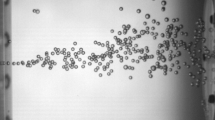Abstract
An experimental study of the bubble deformation in an isotropic homogeneous turbulent flow field was carried out. It is of a fundamental importance to understand the rate of coalescence and breakup in two phase disperse flows.
Third Place of the Gallery of Fluids, XVII National Congress of the Fluid Dynamics Division of the Mexican Physical Society, Guadalajara, Jalisco, Mexico, November 8–11, 2011.
Access provided by Autonomous University of Puebla. Download chapter PDF
Similar content being viewed by others
Keywords
- Homogeneous Isotropic Turbulence
- Bubble Deformation
- Dispersed Flow
- Local Turbulent Reynolds Number
- Particle Image Velocimeter (PIV)
These keywords were added by machine and not by the authors. This process is experimental and the keywords may be updated as the learning algorithm improves.
An experimental study of the bubble deformation in an isotropic homogeneous turbulent flow field was carried out. It is of a fundamental importance to understand the rate of coalescence and breakup in two phase disperse flows. The size of bubbles or droplets has a significant impact on the heat and mass transfer rates in such flows (Risso and Fabre 1998). Several mechanisms has been identified: capillary instabilities, turbulence, to name a few. The turbulent flow field was characterized by Particle Image Velocimeter (PIV) measurements and the bubble dynamics was recorded with a high speed camera both measurements were taken simultaneously. The deformation process was characterized by quantifying bubble aspect ratio at each instant of the process and by measuring the local turbulent Reynolds number at a distance of the diameter size around the bubble. The deformation process was governed by the gradient of turbulent stresses that accelerate some parts of the bubbles surfaces, which induces a redistribution of internal flow and causes a pressure difference inside the bubble which lead to its eventual breakup when this try to recover its original shape.

The sequence of images shows a typical bubble undergoing a break up process. The time step between frames is 5 μs; the initial diameter of the bubble is 3 mm. The flow is characterized by Reλ = 0.623, Wet = 0.04. It can be observed that the bubble undergoes significant deformation and oscillation prior to the actual breakup. We have identified the critical conditions for this process to occur.
Reference
Risso F, Fabre J (1998) Oscillation and breakup of a bubble immersed in a turbulent field. J Fluid Mech 372:323–355
Author information
Authors and Affiliations
Corresponding author
Editor information
Editors and Affiliations
Rights and permissions
Copyright information
© 2013 Springer-Verlag Berlin Heidelberg
About this chapter
Cite this chapter
Mancilla, E., Zenit, R., Ascanio, G., Soto, E. (2013). Bubbles in Isotropic Homogeneous Turbulence. In: Klapp, J., Medina, A., Cros, A., Vargas, C. (eds) Fluid Dynamics in Physics, Engineering and Environmental Applications. Environmental Science and Engineering(). Springer, Berlin, Heidelberg. https://doi.org/10.1007/978-3-642-27723-8_52
Download citation
DOI: https://doi.org/10.1007/978-3-642-27723-8_52
Published:
Publisher Name: Springer, Berlin, Heidelberg
Print ISBN: 978-3-642-27722-1
Online ISBN: 978-3-642-27723-8
eBook Packages: Earth and Environmental ScienceEarth and Environmental Science (R0)




